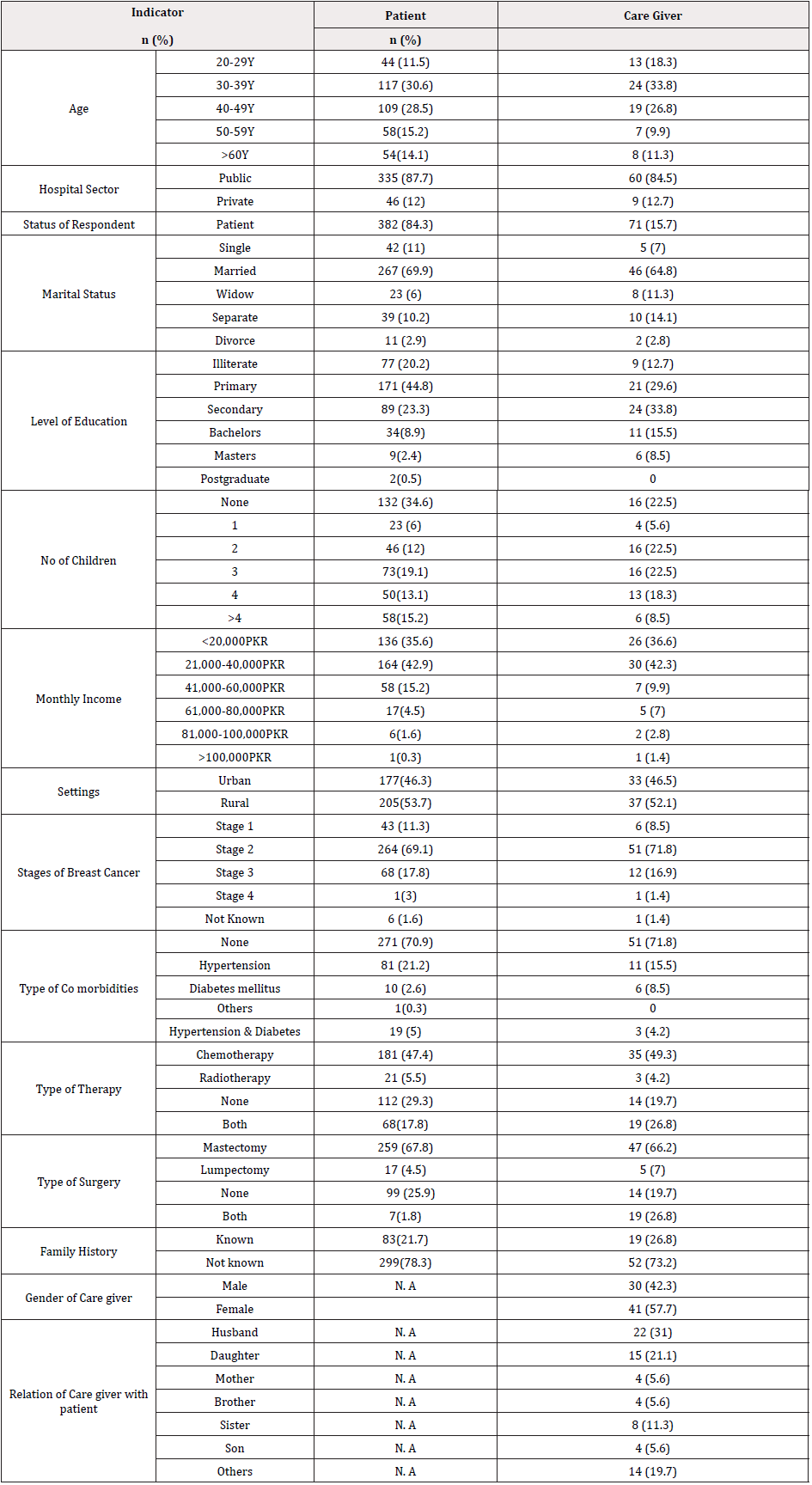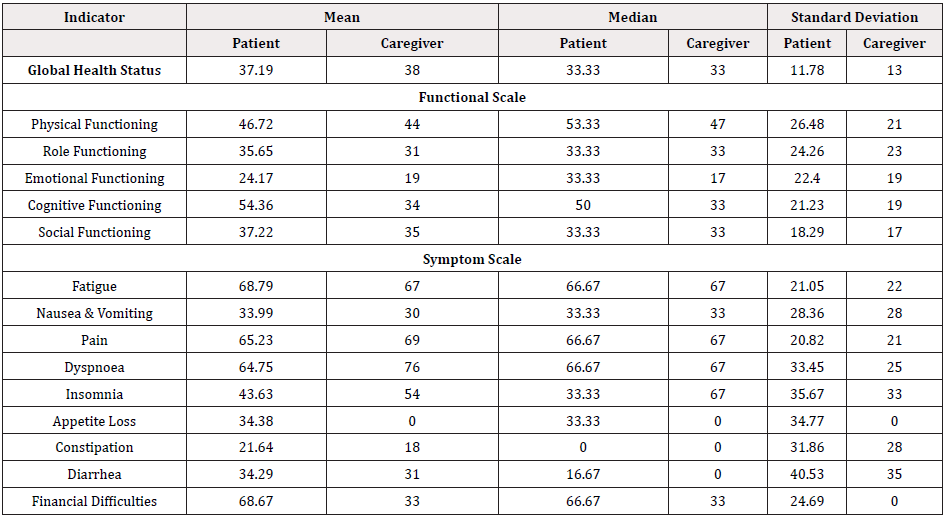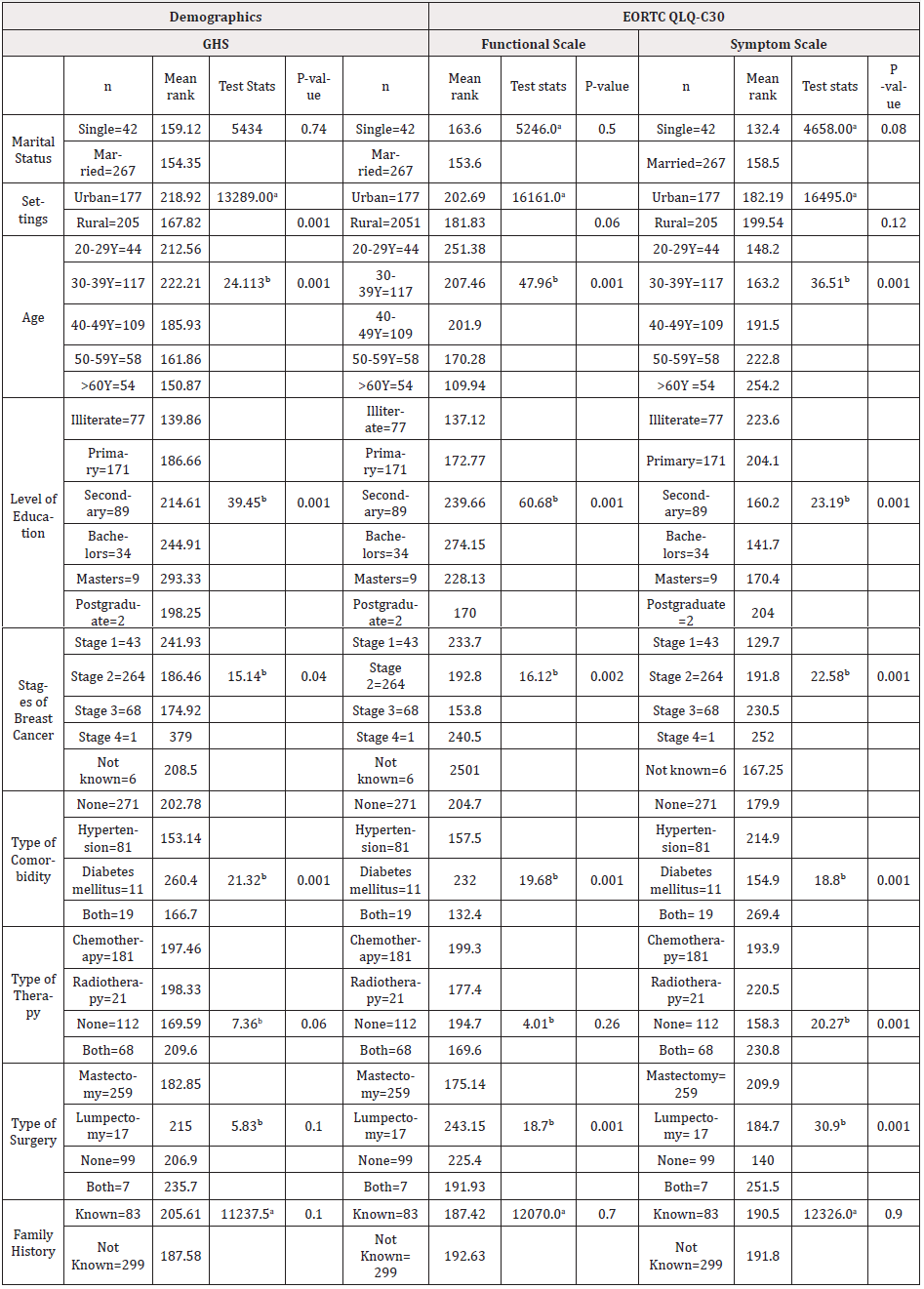Research Article 
 Creative Commons, CC-BY
Creative Commons, CC-BY
Health Related Quality of Life Perceived Among Caregivers and Breast Cancer Patients in Pakistan: Time to Ponder
*Corresponding author: Madeeha Malik, Professor, Director, Hamdard Institute of Pharmaceutical Sciences, Hamdard University Islamabad, Pakistan.
Received: November 20, 2020; Published: January 15, 2021
DOI: 10.34297/AJBSR.2021.11.001663
Abstract
Introduction: Breast cancer has been considered as an emerging non-communicable threat in Pakistan. Limited access to health care facilities, a smaller number of qualified oncologists, lack of technical equipment for diagnosis are the major factors effecting adequate control and prevention of breast cancer in Pakistan.
Objective: The present study was designed to assess health related quality of life among patients of breast cancer in Pakistan.
Methodology: A descriptive cross sectional study design was used to assess health related quality of life among 382 breast cancer patients and 71 care givers using EORTC QLQ C 30. Data was collected and statistically analyzed.
Results: Out of 453 respondents 84.3%, (n=382) were patients while 15.7%, (n=71) were care givers. Out of all the patients, 11.3% (n=43) had stage 1 of breast cancer and 70.9%, (n=271) had no co morbidity. Of all the patients, 47.4% (n=181) were treated through chemotherapy while 5.5% (n=21) through radiotherapy and 67.8% (n=259) underwent mastectomy. The results highlighted that the lowest scores for HRQoL were observed in the domain of symptom scale i.e., constipation (21.64, ±86) followed by domain of emotional functioning (24.17, ±22.40) whereas highest scores were observed in the domains of fatigue (68.79, ±21.05) and financial difficulties (68.67, ±24.69).
Conclusion: Breast cancer patients had poor HRQoL despite self-examination awareness campaigns and advanced therapeutic strategies. The current study concluded that breast cancer had a negative impact on health-related quality of life across all domains in Pakistan. Highest scores were observed in domains of fatigue and financial difficulties whereas, lowest scores for HRQoL were observed in the domain of symptom scale followed by domain of emotional functioning. On the other side, in view of care givers the highest scores perceived were observed in dyspnoea followed by pain.
Keywords: Breast cancer, Health related quality of life, Care givers, Patients, Pakistan, Dyspnoea, Multidimensional, Depression, Therapeutic, Nutritional
Research Article
Breast cancer has been ranked fifth as the most common cause of mortality with nearly 1.7 million new cases diagnosed in 2012 worldwide [1]. The mean prevalence of breast cancer is about 66.7 cases per 100 000 women [2]. In many countries with cutting edge therapeutic care the 5-year survival rate of early diagnosed breast cancer is 80-90% which might get reduced to 24% in case of late diagnosis, resulting in more focus on possible treatment and quality of life of breast cancer patients [1]. Health related quality of life is a subjective and multidimensional concept that is made of expansive areas, by and large including physical, social, emotional, and functional well-being as well as symptoms from breast cancer disease and its treatment. The major issues effecting patient’s quality of life includes mental and emotional effects of illness, diagnostic and therapeutic measures, stress, pain, depression, disease outcomes on family, marital and social relations, additional economic burdens, nutritional issues, and treatment complications [3].
One of the most widely used tool for measuring HRQoL among cancer patients is European organization for research and treatment of cancer quality of life (EORTC QLQ-C30) questionnaire which is specifically designed to measure four key domains of patients namely physical functioning, emotional functioning, fatigue, and pain. EORTC QLQ-C30 questionnaire (English Version) is reliable and valid instrument to determine health related quality of life among breast cancer patients [4]. A study from Netherlands confirmed the importance and benefits of using EORTC QLQ-C30 questionnaire in identifying patients with clinically important problems which could be later intervened by health care professionals [5]. Breast cancer has been considered as an emerging non-communicable threat in Pakistan. One out of every nine women is most likely at the risk to suffer from breast cancer at any stage of their life mainly due to lack of access to screening facilities & specialty hospitals.
Poor Socio-economic status, lower educational background, socially stigmatized situation, and paucity of early detection programs are also responsible for adding towards cancer burden in Pakistan. Most of the breast cancer patients experience depression. Limited access to health care facilities, a smaller number of qualified oncologists, lack of technical equipment for diagnosis are the major factors effecting adequate control and prevention of breast cancer in Pakistan. The importance of health-related quality of life and its determinants including physical, emotional, and functional domains among breast cancer women has long been recognized in developed world but in developing countries including Pakistan, this concept is still in infancy, although its rate has been increasing at an alarming rate in Pakistan. Limited studies have assessed health related quality of life among breast cancer patients in Pakistan. Therefore, the present study was designed to assess health related quality of life among patients of breast cancer in Pakistan.
Methodology
A descriptive cross-sectional study design was used to determine the health-related quality of life among patients of breast cancer in Pakistan. Study approval was taken from the Ethical Committee of Hamdard University (Ref ERBHUIC 00178). Approval was also taken from Medical superintendents of different public and private healthcare facilities located in Islamabad (Federal Capital) and Rawalpindi (Twin city). Patients were briefed regarding nature and objectives of the study and verbal and written consent were obtained prior to data collection. Respondents were assured of the confidentiality of their responses and their right to withdraw from the study at any time. Study respondents included patients diagnosed with breast cancer and their caregivers. Patients having age 20 years and older, diagnosed with breast cancer and who could speak & understand Urdu or English were included, while all other cancer patients other than breast cancer and patients not willing to participate were excluded.
Sample Size & Sampling Procedure
Sample size was calculated using Raosoft® sample size calculator. Sample size was calculated to be 382 patients to achieve 95% confidence level with 5% margin of error, while amongst the care givers of patients, 71 caregivers filled HRQoL questionnaire. As no updated list of number of breast cancer patients in twin cities is available, convenient sampling technique was used. According to convenient sampling technique all the available respondents that were present at the time of data collection were included in study.
Data Collection Tool
A pre-validated EORTC QLQ C 30 was used to measure Health Related Quality of Life for patients and their caregivers and written permission had been obtained from the Quality-of-Life Group. Pilot testing was performed on 10% of sample size to confirm reliability of tool. The value of Cronbach’s alpha was 0.71 for European Organization for Research and Treatment of Cancer Quality-oflife Questionnaire Core 30 (EORTC QLQ C30). EORTC QLQ-C30 is most widely used health related quality of life questionnaire in cancer research. It consisted of five functional scales (physical, role, emotional, cognitive, and social), three symptom scales (fatigue, nausea & vomiting and pain) and a global health status/QOL scale. Furthermore, it contains six single items (dyspnoea, insomnia, appetite loss, constipation, diarrhoea and financial difficulties).
Scoring of the Tool
Items response data was entered. Scoring of the EORTC QLQ C 30 was begun with ensuring that the questionnaire was complete. The ‘n’ item response values were recorded. After item recording, estimated the average of the items that contribute to the scale; this is the raw score. And afterwards through linear transformation to standardize the raw score. All the scales and single-item measures ranged in score from 0 to 100. Higher score for the functioning scales and global health status denoted a better level of functioning (i.e., a better state of the patient), while higher scores on the symptom and single-item scales indicated a higher level of symptoms (i.e., a worse state of the patient). For all scales, the Raw Score, RS, is the mean of the component items: Raw Score =RS= (I1 + I 2 +...+ In)/n. Then for Functional scales: Score =1- (RS-1)/range×100 and for Symptom scales/items and Global health status/QoL: Score={(RS-1)/range} ×100. “Item range” is the difference between the possible maximum and the minimum response to individual items.
Data Collection and Analysis
Data was collected by the principal investigator trained by the supervisor. The questionnaire was self-administered to the respondents and collected back on the same day to avoid biasness. Response rate of data collection in patients of breast cancer were 100% (382/382 ×100) and among care givers of patients were recorded as 18.5% (71/382 ×100). After data collection, data was cleaned, coded, and entered in SPSS version-21. Descriptive statistics comprising of frequency and percentages were calculated. The nonparametric tests including Mann-Whitney and Kruskal- Wallis (p≥0.05) were performed to find out the difference among different variables.
Results
Out of 453 respondents 84.3%, (n=382) were patients while 15.7%, (n=71) were care givers. Out of 382 patients, 11.5% (n=44) were in age range 20-29 while 14.1%, (n=54) were greater than sixty years old. Of the total patients, 87.7% (n =335) got treatment from public sector while 12% (n=46) from private sector. Out of all the patients, 20.2% (n=77) were illiterate, while 44.8% (n=171) were matric. Out of all the patients 11.3% (n=43) had stage 1 of breast cancer and 70.9%, (n=271) had no co morbidity. Of all the patients 47.4% (n=181) were treated through chemotherapy while 5.5% (n=21) through radiotherapy and 67.8% (n=259) underwent mastectomy (Table 1). The results highlighted that the lowest scores for HRQoL were observed in the domain of symptom scale i.e., constipation (21.64, ±31.86) followed by domain of emotional functioning (24.17, ±22.40) whereas highest scores were observed in the domains of fatigue (68.79, ±21.05) and financial difficulties (68.67, ±24.69).
On the other side, in view of caregivers the highest scores perceived for the patients were observed in Dyspnoea (76, ±25) followed by pain (69, ±21). A detailed description is given (Table 2). Comparison of HRQoL domains in different age groups demonstrated a relatively significant difference (p=0.001) with breast cancer patients aged more than 60 years having worst HRQoL scores. Analyzing the scores of the respondents with different marital status reported better functioning (p=0.08) among married breast cancer patients. Significant difference (p=0.001) was observed among different stages of breast cancer with stage 3 patients reported increased symptoms. Furthermore, comparison of HRQoL domains across different types of surgery revealed a comparatively significant difference (p=0.001) with worst symptom scale reported among patients who underwent both chemotherapy and radiotherapy. Moreover, significant difference (p=0.001) was found in breast cancer patients receiving radiotherapy. A detailed description is given (Table 3).
Discussion
Breast cancer has become one of the most prevailing cancer among the women worldwide bringing about expanded morbidity and mortality. Due to prolonged therapy and recurrence of breast cancer, patients suffer from physical, emotional, social, and sexual discomfort leading towards poor disease outcomes. Estimation of HRQoL is important in breast cancer, as it helps both patients and physicians in choosing better treatment option and in return improving health outcomes of patients. The results of the current study featured a consequential impact on several domains of HRQoL among breast cancer patients and their caregivers. Lowest scores for HRQoL were observed in the domain of symptom scale i.e., constipation followed by domain of emotional functioning whereas highest scores were observed in the domains of fatigue and financial difficulties. These findings are in concordance with a study from Germany in which mean score in domain of financial difficulties was reported as highest [6].
EORTC QLQ C30 has been most widely used tool consisting of GHS, functional and symptom scales and the scores provide useful information of disease on various dimensions of affected individuals. Most of the breast cancer patients enrolled in this study considered their health and QoL as poor which might be due to poor Socio-economic status and psychological crisis among breast cancer patients, on contrary to another study findings from Pakistan where breast cancer patients reported their GHS as clinically poor [7]. About functional scale, the results of the current study revealed that most of breast cancer patients had difficulty in remembering things and their physical condition interfered with their family life and social activities and except cognitive functioning (moderate) all of the other domains including physical, role, emotional and social functioning were reported poor. Similarly, these findings are in accordance with a study from Kuwait where most of the patients also stated their emotional, social, role and physical functioning poor [8].
On symptom scale, the results of the present study unveiled that most of the breast cancer patients reported pain, dyspnoea, fatigue and financial difficulties and among all of the breast cancer patients, very few of them reported appetite loss, constipation and diarrhea. Moreover, the results of the present study revealed that breast cancer patients in stage three, who had mastectomy and on chemotherapy had relatively low health related quality of life. Illiterate breast patients reported worst HRQoL across all domains except in domains of insomnia, appetite loss and constipation. These findings are consistent with a study conducted in Sweden where majority of the breast cancer patients suffered from pain, dyspnoea, fatigue and financial difficulties [9].
Caregivers play an important role in determining quality of life of patients as they have more keen observation of their patients under variety of circumstances. The results of the current study revealed that most of the care givers considered their patient’s quality of life and health as mediocre. In their view, breast cancer patients had trouble doing strenuous activities, in taking a long and short walk and pursuing their hobbies. They felt worried, irritable, and depressed and have difficulty in concentrating on things like reading a newspaper or watching television. Similarly, poor health related quality of life was reported among the patients in Ethopia which highlighted that physical condition interfered with the family life and social activities of breast cancer patients [10-15].
Limitations of the Study
The main issues faced during the study were time and financial constraints and cross-sectional study design which does not show cause and effect relationships. Furthermore, the results of this study were limited to two cities of Pakistan and should not be generalized to other parts of country.
Conclusion
Breast cancer patients had poor HRQoL despite self-examination awareness campaigns and advanced therapeutic strategies. The current study concluded that breast cancer had a negative impact on health-related quality of life across all domains in Pakistan. Highest scores were observed in domains of fatigue and financial difficulties whereas, lowest scores for HRQoL were observed in the domain of symptom scale followed by domain of emotional functioning. On the other side, in view of caregivers the highest scores were observed in dyspnoea followed by pain. Necessary health educational and psychological interventional programs targeting patients as well as care givers with lower educational programs should be initiated to improve awareness and to reduce depression among breast cancer patients as well as their caregivers.
Funding Statement
The study received no funding.
Conflict of Interest
The authors declare no conflict of interest.
Ethics
Not applicable.
References
- Ferlay J, Soerjomataram I, Ervik M, Dikshit R, Eser S (2015) Cancer incidence and mortality worldwide: sources, methods, and major patterns in GLOBOCAN 2012. Int J Cancer 136(5): 359-386.
- ACS (2009) American Cancer Society.
- Shakeri J, Abdoli N, Paianda M, Chareh Ga G (2009) The frequency of depression among patients with breast cancer in Kermaneshah U.M.S chemotherapy centers in 2007. J Medical Council of Islamic Republic of Irans 27: 324-328.
- Luo N, Fones C, Lim SE, Xie F, Thumboo J (2005) The European Organization for Research and Treatment of Cancer Quality of Life Questionnaire (EORTC QLQ-C30): Validation of English Version in Singapore. Quality Life Research 14(4): 1181-1186.
- Giesinger JM, Kuijpers W, Young T, Tomaszewski KA, Friend E, et al. (2016) Thresholds for clinical importance for four key domains of the EORTC QLQ-C30: physical functioning, emotional functioning, fatigue, and pain. Health Quality Life Outcomes 14: 87.
- Waldmann A, Pritzkuleit H, Katalinic RA (2007) The OVIS study: Health related quality of life measured by the EORTC QLQ-C30 and -BR23 in German female patients with breast cancer from Schleswig-Holstein. Quality of Life Research 16: 767-776.
- Saleha SB, Shakeel A, Shumaila E, Shazia R, Rashid R (2010) An assessment of quality of life in breast cancer patients using EORTC QLQ C30/+BR23 questionnaire.
- Alawadi SA, Ohaeri JU (2009) Health-related quality of life of Kuwaiti women with breast cancer: a comparative study using the EORTC Quality of Life Questionnaire. BMC Cancer 9: 222.
- Michelson H, Bolund C, Nilsson B, Brandberg Y (2000) Health-related Quality of Life Measured by the EORTC QLQ-C30: Reference Values from a Large Sample of the Swedish Population. Acta Oncologica 39(4): 477-484.
- Bekele MA (2016) Assessing the quality of life among patients with breast cancer at Tikur Anbassa specialized hospital, Addis Ababa, Ethiopia.
- Bantema Joppe EJ, De Bock GH, Woltman Van IM, Busz DM, Ranchor AV, et al. (2015) The impact of age on changes in quality of life among breast cancer survivors treated with breast-conserving surgery and radiotherapy. Br J Cancer, 112(4): 636-643.
- Moro Valdezate, D, Buch Villa E, Peiró S, Morales M, Caballero Gárate A (2014) Factors associated with health-related quality of life in a cohort of Spanish breast cancer patients. Breast Cancer 21(4): 442-452.
- Venturi S (2001) Is there a role for iodine in breast diseases? Breast 10(5): 379-382.
- Groenvold M (2010) Health-related quality of life in early breast cancer. Dan Med Bull 5(9): B4184.
- Menhas R, Umer S (2015) Breast Cancer among Pakistani Women. Iran J Public Health 44(4): 586-587.






 We use cookies to ensure you get the best experience on our website.
We use cookies to ensure you get the best experience on our website.